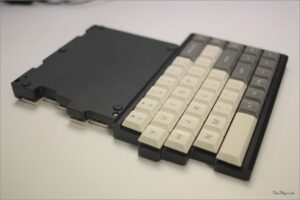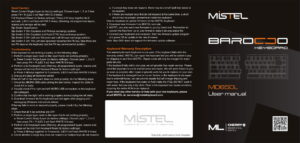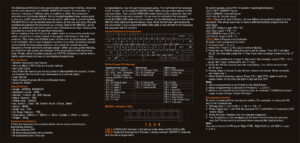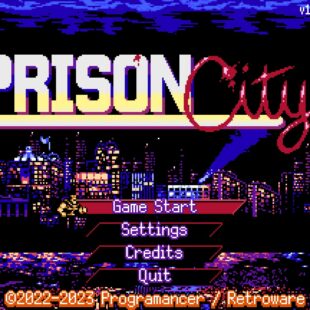Mistel Barocco MD 650L – Review
In practice
As soon as the 650L arrived I started to use it on my work machine, swapping my now 5-year-old Ducky Year of the Snake for this compact and ergonomic replacement.
The first thing to note is just how slim the 650L is. It does come with some feet that can be attached to the back of the keyboard but even with these it doesn’t gain too much in height.
You even get a slightly longer piece which can be used to connect the two halves more permanently. This keeps the two halves secure together and helps reduce movement.
The case is made from aluminium and because of this has quite a nice sturdiness about it. It is also nice and heavy which means that as long as it is on a flat surface it shouldn’t move about.
The keycaps used are nice and bright, contrasting the black chassis very nicely. These too are low profile as required by the keys witch in use.
The key switches used by Mistel here are Cherry ML, which are an old switch, but they are a very solid design and are perfect where having a low profile is key requirement.
The Cherry ML Switches are one of the lowest profile switches that Cherry ever made, with a height of only 6.9 mm which is even lower than the MX Low Profile switches that were recently announced.
Though ML switches do have the downside of not having a common keycap fitment, so replacement keycaps will be few and far between.
The actual switches have a nice tactile action and remind me of Cherry MX Brown switches. Although the tactile part is far more noticeable.
These are ideal in my opinion as they give the perfect amount of feedback on each keypress.
The keycaps, are nice and smooth and are ABS, so whilst hard wearing, they might begin to shine with a lot of use.
Like the Barocco MD600 before it, you use a connecting cable to pair the halves up, this time it is not coiled and it is a bit longer so you can have the keyboard spaced out a lot more which suits me to the ground, although I would have liked to see a coiled cable be included as an option. (considering the price)
You then connect the right hand side of the keyboard (which is the primary half) to your PC and you are good to go.
Firmware
The Barocco MD650L features a purpose-built firmware which is packed full of features, some of which make a return from the MD600 and some new.
The indicators down in the bottom right make a return and show the various modes.
LED1 – is the caps lock indicator
LED2 – Shows the change in keyboard layout. With the indicator changing colour for QWERTY, COLEMAK and DVORAK.
LED3 – Shows the layer of the keyboard you are working from, there are 4 layers including the default one so you can save a vast amount of macro’s to make the most use of the 65% layout.
LED4 – This shows that you entered the macro programming mode
To save posting the full steps, I will link the full manual below as well.
The macro options are quite simple, requiring you to choose a layer and then hit Fn + Right Control, then double tap the key for the macro, then press the macro you want to be saved and finally hit Pn key.
It sounds like a lot of steps but is surprisingly simple to get going. The main problem is remembering what layer you have saved them to.
Underneath are a few dip switches which will allow you to change a few of the keys positions including the Caps Lock, Fn, Right Ctrl, Windows and Left Alt. These are fixed depending on what dip switch is flipped and are fully documented in the manual once again.







